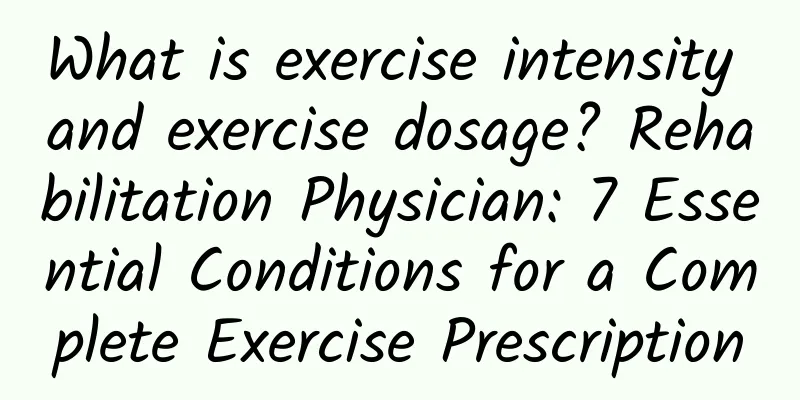What is exercise intensity and exercise dosage? Rehabilitation Physician: 7 Essential Conditions for a Complete Exercise Prescription

|
As modern society becomes more and more convenient, people's lifestyles, the nature and content of their work have changed fundamentally from before. Coupled with changes in eating habits, stress and other factors, the proportion of overweight and obesity has continued to rise. The accompanying diseases, medical treatment and social costs have gradually become issues of focus for the public health and medical systems in recent years. In order to deal with and solve these problems, the concepts of physical fitness, physical activity and exercise have become fashionable topics of public concern in recent years. Fitness, physical activity and sports Before we talk about physical fitness, we first need to understand the difference between physical activity and exercise. According to the American College of Sports Medicine (ACSM), physical activity refers to any body movement caused by skeletal muscle contraction that results in a significant increase in caloric demand compared to energy expenditure during rest; while exercise is a type of physical activity that specifically refers to planned, structured, repetitive physical movements intended to increase one or more areas of physical fitness. Physical fitness refers to a person's ability to have the strength and agility to carry out daily activities without excessive fatigue, and to have sufficient energy to enjoy leisure activities and cope with emergencies. Physical fitness is composed of various elements, which can be divided into health-related and skill-related physical fitness. Health-related fitness is composed of cardiorespiratory endurance, body composition, muscle strength, muscle endurance and flexibility; while skill-related fitness is composed of agility, coordination, balance, power, reaction time and speed. Exercise Tips In recent years, the concept of exercise has emerged, but how and to what extent to obtain the benefits of exercise, and what kind of exercise is enough, these questions often bother everyone when they first start to exercise. First of all, regarding exercise intensity, metabolic equivalents (MET) are often used clinically to represent exercise intensity. One metabolic equivalent (1 MET) refers to the energy consumed by a person at rest, and the number before the metabolic equivalent represents how many times the energy consumed by exercise or activity is compared to that at rest. Generally speaking, 2.0-2.9 metabolic equivalents represent light activity, 3.0-5.9 metabolic equivalents represent moderate activity, and more than 6.0 metabolic equivalents represent vigorous activity. More and more studies have shown that there is a dose-response relationship between physical activity or exercise and health, which means that within a certain range, the more exercise you do, the more health benefits you can get. The dose of exercise is expressed as the intensity of exercise multiplied by the duration of exercise. Many people may have heard that they should exercise at least three times a week for 30 minutes each time. Such advice may seem simple, but it is easy to cause misunderstanding or lack of details in practice. Therefore, the American College of Sports Medicine and the American Heart Association (AHA) have proposed more detailed physical activity guidelines for adults. The details will be further explained later in this article. Physical energy measurement Cardiopulmonary function is an important indicator of health, and the measurement of cardiopulmonary function can be expressed as the maximum oxygen uptake per unit time (VO2max). In addition to formal cardiopulmonary function tests in rehabilitation or cardiology departments, VO2max measurement can also be obtained by converting heart rate and other physiological reactions obtained through simpler standardized running or walking tests. In addition to cardiopulmonary function, muscle strength and endurance play an indispensable role in bone and bone health, muscle mass, glucose tolerance, basal metabolism and daily life functions. Muscle strength can be divided into static muscle strength and dynamic muscle strength. Static muscle strength can be measured using a tensiometer or dynamometer, or even a simple handgrip. Dynamic muscle strength can be measured using the 1-RM (Repetition of Maximum) method, which means the weight that can only be lifted once with the correct posture and full range of motion. Muscular endurance can be measured by performing repetitions of a fixed weight or a percentage of the 1-RM until muscle fatigue is achieved. Flexibility is also an important part of physical fitness. It refers to the ability to move a specific joint through its full range of motion. It can be measured directly with a protractor at specific reference points in a standard posture or using an inclinometer or tape measure. Exercise prescription Finally, let’s talk about simple exercise prescriptions. A complete exercise prescription should include FITT-VP (Frequency Intensity Time Type, Volume Pattern and Progression), namely frequency, intensity, time, type, volume, exercise pattern and progression. We will discuss aerobic exercise, strength training and flexibility training respectively. First, aerobic exercise. It is recommended that adults aged 18 to 65 should engage in moderate aerobic exercise for 30-60 minutes at least five days a week or vigorous aerobic exercise for 20-60 minutes at least three times a week. You can also mix the above two intensities and time to do aerobic exercise for more than three to five days. If you cannot accumulate 30 minutes at a time when participating in moderate aerobic exercise, you can do it in segments from 10 minutes each time. The above, cumulative exercise of more than 30 minutes is also acceptable. Regular and rhythmic activities of large muscle groups are preferred. The cumulative amount of exercise is recommended to reach 500-1,000 metabolic equivalent minutes (MET-min) per week, or gradually increase from more than 2,000 steps a day to more than 7,000 steps a day. The progression of exercise is to gradually increase the length and frequency of exercise first, and finally increase the intensity of exercise. For strength and endurance training, the recommended training frequency is 2-3 days a week. The recommended intensity and number of reps for the average person is 60-70% of 1-RM, with 8-12 reps. For the elderly, it is recommended to use 40-50% of 1-RM, with 10-15 reps for strength training. If the focus is on endurance, it is recommended to use <50% of 1-RM, with 15-25 reps. It is recommended that every major muscle group should be trained, with multi-joint exercises being prioritized and single-joint exercises being supplemented. You can also use common sports equipment on the market or use your body weight for training. The recommended number of training sets is 2-4 sets, and 2-3 minutes of rest is recommended between each set. There should be an interval of more than 48 hours between two training sessions for the same muscle group. The training progression is to first increase the number of exercises and sets in each set and then increase the weight. Regarding flexibility training, the recommended frequency is 2-3 days a week or more, stretching to the point of being a little tight or a little painful. If it is static stretching, it should last for more than 10-30 seconds. For the elderly, it is recommended to maintain it for more than 30-60 seconds. The type of exercise should include stretching all major muscle-tendon units. Whether dynamic stretching, static stretching, ballistic stretch, or proprioceptive neuromuscular facilitation (PNF), the training effect can be achieved. It is recommended to do each stretch 2-4 times, accumulating to more than 60 seconds for each stretch. Before stretching, you can do some active warm-up or passive heating of the muscle groups such as hot compresses or hot baths to increase the extensibility of the muscle-tendon units. It is never too late to start exercising, and there is no age limit for training. After consulting a doctor, the elderly and patients with chronic diseases can also engage in training to increase cardiopulmonary function, muscle strength, endurance and flexibility. I hope that after reading this article, everyone can exercise more safely and confidently and get the health benefits. |
Recommend
What foods are good for endometrial thickening?
Endometrial thickening may lead to irregular mens...
Is vomiting before menstruation a disease?
Is vomiting before menstruation a disease? Vomiti...
How is endometrial tuberculosis transmitted?
What are the ways of transmission of endometrial ...
How to treat mild cervical erosion? Detailed description of the scientific treatment method for mild cervical erosion
Professor Geng Xiaoxing, director of the Second G...
What should I pay attention to in my diet for pelvic inflammatory disease?
What should you pay attention to in your diet for...
Is the dark area of rectal fluid an ectopic pregnancy?
Ectopic pregnancy refers to ectopic pregnancy. Th...
The cost and taboos of uterine-protection abortion
In today's society, many young people get pre...
Why does brown blood flow after abortion? 3 reasons for brown blood flow
Brown bleeding often occurs after an abortion, wh...
What to do if menstrual irregularity is caused by artificial abortion?
What should I do if I have irregular menstruation...
How to take good care of congenital absence of vagina in life
I believe everyone knows that there are many symp...
"Light" tonic in winter! Wolfberry and crucian carp soup nourishes the body and brain
The cold winter is coming, which means it’s time ...
How to check for bacterial vaginosis
Some people are usually very curious, why unmarri...
Is pelvic peritonitis a serious disease?
Is pelvic peritonitis a serious disease? Pelvic p...
Ovarian cyst surgery requires hospitalization
Ovarian cyst surgery requires hospitalization Reg...
Ovarian cyst surgery sequelae
Ovarian cyst surgery has sequelae. Many women hav...









